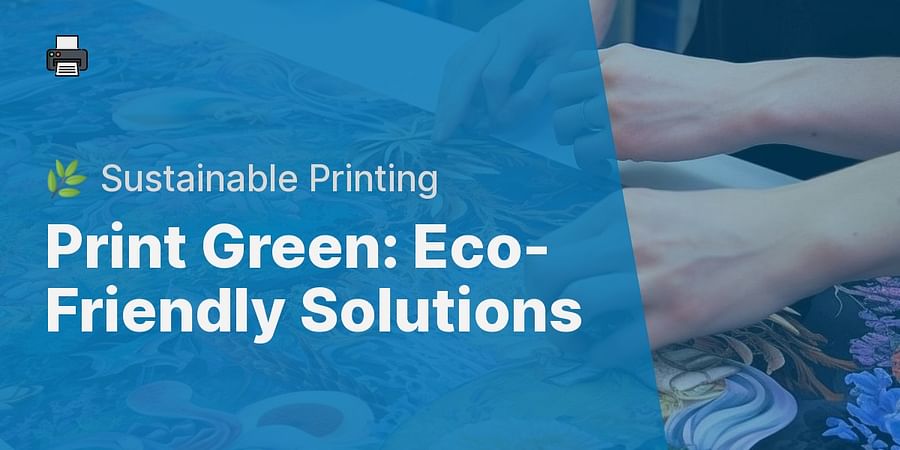Going Green with Your Printing: Best Eco-Friendly Practices and Products

As a small business owner, your printing practices can have a significant impact on the environment. From the energy used to power printers to the disposal of ink cartridges and paper waste, every aspect of printing can contribute to your business's environmental footprint. By adopting eco-friendly printing practices and products, you can reduce your impact and contribute to a more sustainable future. This not only benefits the planet but also improves your bottom line by reducing costs and enhancing your brand's reputation.
Some of the key environmental benefits of eco-friendly printing include:
Adopting eco-friendly printing practices and products is a smart choice for small businesses looking to reduce their environmental impact and improve their bottom line. In the following sections, we'll explore the best eco-friendly printing practices and products for your business.

As a small business owner, adopting eco-friendly printing practices can help you reduce your environmental impact and save on printing costs. Here are some practical tips and strategies:
1. Print double-sided: Use the built-in duplex printing feature to reduce paper consumption.
2. Use recycled paper: Opt for paper with a high percentage of post-consumer recycled content and certification from organizations like the Forest Stewardship Council (FSC).
3. Optimize document layout: Review your document layout to minimize paper usage by reducing margins, using smaller font sizes, and eliminating unnecessary images or graphics.
4. Go digital whenever possible: Encourage employees to use digital documents and communication tools instead of printing.
5. Implement a print management system: Monitor and control printing activities to reduce waste and unnecessary printing.
6. Perform regular printer maintenance: Keep printers in good condition to reduce wasted ink and paper due to printing errors.

By implementing these eco-friendly printing practices, your small business can contribute to a greener environment while enjoying cost savings and improved efficiency.
When choosing an eco-friendly printer for your office, look for ENERGY STAR certification, recycled materials, and low environmental impact. Here are some top options:
1. HP Color LaserJet Pro MFP M477fdw: ENERGY STAR certified, uses up to 50% less energy, automatic duplex printing, and is made with 20% recycled materials.
2. Epson WorkForce Pro WF-4740: ENERGY STAR certified, uses up to 80% less power, automatic duplex printing, and is made with up to 90% recycled plastic.
3. Brother HL-L2350DW: ENERGY STAR certified, automatic duplex printing, and made with 80% recyclable materials.
Choosing an eco-friendly printer reduces your environmental impact and saves money on energy and supplies.
Choosing eco-friendly ink and toner is crucial for sustainable printing. Consider these options:
1. Refillable Ink and Toner Cartridges: Refillable cartridges reduce waste and save money.
2. Recycled Ink and Toner Cartridges: Recycled cartridges reduce waste and support a sustainable printing industry.
3. Vegetable-Based Inks: Vegetable-based inks are made from renewable resources and produce fewer volatile organic compounds (VOCs).
Choosing eco-friendly ink and toner reduces waste, saves money, and supports sustainability.
Proper recycling and disposal of printer supplies reduce your environmental impact. Follow these tips:
1. Ink and toner cartridges: Use manufacturer recycling programs or designated collection points.
2. Printers and other hardware: Recycle old equipment at electronics retailers or recycling centers.
3. Paper and cardboard: Use designated recycling bins and local recycling programs.
Recycling and disposing of printer supplies responsibly minimizes waste and protects the environment.
Reducing paper waste is essential for eco-friendly printing. Try these strategies:
1. Double-sided printing: Use the double-sided printing feature to cut paper usage in half.
2. Print preview: Use print preview to avoid unnecessary pages and formatting errors.
3. Use digital documents: Opt for digital documents whenever possible to save paper.
4. Reuse and recycle: Reuse paper and recycle used paper to minimize waste.
5. Paper-saving software: Use software tools to optimize documents for printing and save paper.
Implementing these strategies reduces paper waste, conserves resources, and saves money.
Eco-friendly printing practices and products offer cost savings for your business. Consider these benefits:
1. Lower energy consumption: Energy-efficient printers reduce electricity costs.
2. Reduced ink and toner costs: Eco-friendly ink and toner options save money on supplies.
3. Less paper waste: Paper-saving practices reduce paper costs.
4. Longer-lasting printers: Durable eco-friendly printers require less frequent replacement.
Adopting eco-friendly printing practices leads to cost savings and a greener bottom line.
Making the switch to eco-friendly printing is a responsible choice that benefits the environment and your business. By adopting eco-friendly practices, investing in energy-efficient printers, and using sustainable ink and toner, you can reduce your carbon footprint and contribute to a greener future.
Remember, every small step counts. Educate employees, promote your eco-friendly initiatives, and stay informed about advancements in sustainable printing technology. By evaluating your current practices and making improvements, your business can become a leader in eco-friendly printing solutions.

Post a comment